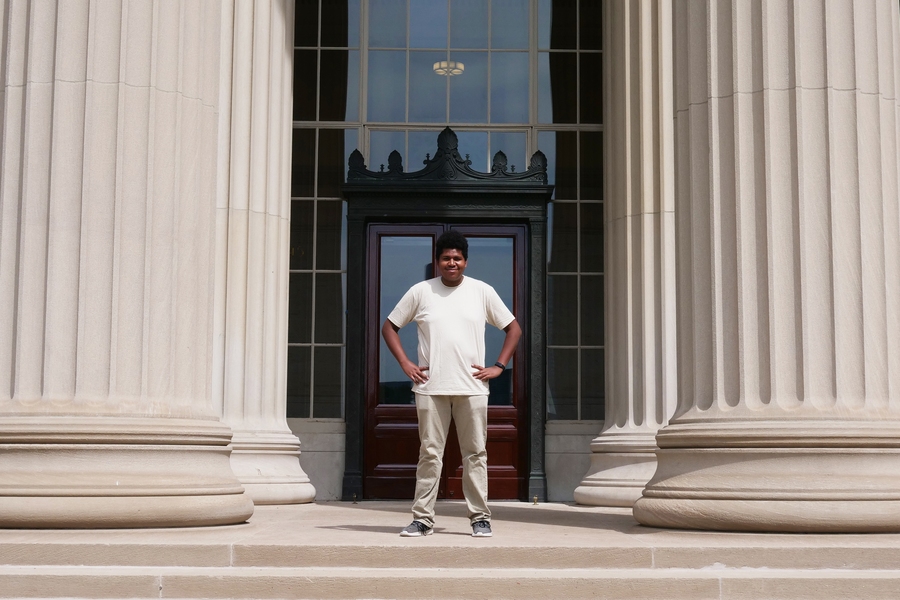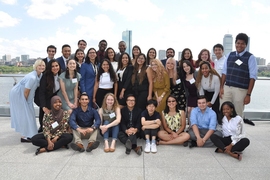Meucci Ilunga seems to know something about everything. He’s a videographer who’s branching out into podcasting. He’s researched cancer therapies and volunteered in a hospital. He grew up on a Navajo reservation, and he’s a year away from completing a biochemistry degree at the University of Arizona. “I’m excited about life in general,” he says. At the moment, though, he’s especially excited about a cellular conundrum that he investigated during the 10-week internship in the MIT Department of Biology that he completed as part of the MIT Summer Research Program in Biology (MSRP-Bio).
“Your cells are really, really complicated,” he says. “They’re packed with lots of different kinds of proteins. Yet when you look at how proteins interact, they’re specific.” How do proteins find the appropriate binding partners amongst all the noise? Ilunga and his MSRP-Bio supervisor, biology and biological engineering Professor Amy Keating, think that short sequences of amino acids — the units that comprise proteins — can mediate binding interactions more intricate than researchers had previously appreciated.
Just as proteins home in on their binding partners, Ilunga has always been drawn to science. As a kid, he told everyone he wanted to be an astrophysicist. “I had no idea what that meant,” he says, “but I loved the idea of exploring the unknown and being able to generate knowledge.”
Ilunga grew up on the Navajo reservation in Kinlichee, Arizona, however, and he didn’t have the same opportunities to engage in science as kids in urban centers. “Only about 60 percent of people on the reservation have running water and electricity,” he says, “so most people are pressed with more urgent matters than following their curiosities.”
Ilunga notes the myriad of difficulties his reservation faces, from prevalent diabetes to corrupt politicians and poor school systems, but says that the hardest part about being Navajo is feeling like his people’s problems are invisible to those outside the tribe. “A lot of us feel very forgotten about,” he says.
Ilunga quickly exhausted the opportunities that his high school in Fort Defiance, Arizona, had to offer, leading him to graduate early and leave for the University of Arizona at age 16. But he was determined to remember his roots. Balancing his love of science with his connection to the reservation — and finding a career that will let him return — has proven challenging.
“You can become an engineer, but there are no engineering jobs on the reservation. You can become a computer scientist, but there are no computer science jobs,” he says. So he decided to pursue biochemistry, as it would lay the foundation for medical school, and the reservation is always in need of doctors.
At his university, Ilunga started shadowing physicians and volunteering in a hospital. His path to medical school seemed clear. There was only one problem: He found medicine unfulfilling. “There’s so much more I could be doing. So I started looking at what else I could do to get back home,” he says.
This desire for balance is what made Ilunga choose to join the MSRP-Bio program, for which he received sponsorship from the Gould Fund. Ilunga met the MSRP-Bio coordinator, Mandana Sassanfar, at a conference for minority students, and she told him that MSRP-Bio promotes a balance between lab work and life. “What sold me on this program is that it understands that I’m more than just a scientist,” he says.
Over the summer, Ilunga has spoken with many MIT professors about the diverse professional paths scientists can take, and these conversations have inspired him to consider a career in policy.
“I could be someone who goes to Congress to fight — not only for Native American affairs, but also for scientific affairs,” he says.
Ilunga plans to pursue a PhD in life sciences in preparation for this career, possibly studying protein interactions like the ones he’s been working on all summer. He finds research most interesting when it has a clear clinical application, and understanding protein interactions lets researchers design drugs that disrupt them.
The protein interactions that Ilunga researched are mediated by sequences called short linear motifs, or SLiMs, which consist of contiguous stretches of only three to 10 amino acids — a small subset of the hundreds of amino acids that make up the typical protein. While larger domains are able to form tighter and more sustained interactions, SLiMs mediate weaker, transient interactions.
SLiMs make up in speed what they lack in strength. Allowing proteins to quickly bind and release each other is beneficial for some biological processes, and SLiMs can also evolve rapidly and let organisms adapt to change quickly. Researchers think this is why SLiMs have persisted in many different organisms over the course of evolution, despite being relatively unintuitive tools for forming protein complexes. The Keating lab noticed that sometimes proteins that contain SLiMs recognize their binding partners with a specificity that’s unexpected, given that so many proteins contain these short sequences.
Ilunga spent his summer looking into how small domains and short sequences can play a large role in protein pairing. His weeks began with culturing large quantities of bacteria that were used to produce SLiM-containing peptides; then he isolated these peptides and used a technique called biolayer interferometry to determine how tweaking their amino acid sequences affected how strongly they bound their target protein.
When he altered the amino acid sequence directly adjacent to the SLiMs, Ilunga found that the strength of their binding interactions could vary quite wildly. The Keating lab doesn’t understand how this occurs, and Ilunga’s findings pave the way for testing different biochemical mechanisms to explain this phenomenon.
When he wasn’t isolating proteins or chatting with the MIT faculty, Ilunga got to know the MIT community. “At a lot of top schools there’s a sense of prestige that fills the air, but it wasn’t like that at MIT. Everyone here is so humble,” he says.
He especially enjoyed getting to know his fellow MSRP-Bio students. Whether they were going on a boat cruise along the Charles River or helping each other troubleshoot lab work, he says it was an amazing group of people to spend the summer with.
As he heads back to the University of Arizona, Ilunga is taking many technical skills back with him, as well as a new outlook on life. He has always been hopeful that life will get easier for Navajos and other minorities. Now he’s confident that the medical and technological advances that institutions like MIT are creating can improve living conditions for people like his family back on the reservation.
“I used to think my optimism was blind,” he says. “Now I think my optimism is informed.”








